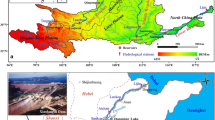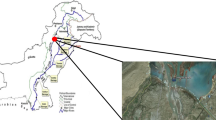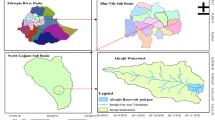Abstract
The modern climate trend and population growth have dramatically increased the need for maximization of the net benefit from the existing storage space in freshwater reservoirs. However, sedimentation in reservoirs through physical deposition and/or slope failures is a major threat to their productivity and life expectancy. In this context, the sedimentation impact on the sustainability of Mornos Lake/Reservoir, which is exceptionally vital for the ~ 3.1 million inhabitants of Athens, had to be evaluated. Therefore, a meticulous geophysical survey of the reservoir bed was conducted in 2015 for the very first time. Bathymetric, sidescan sonar, and seismic profiling datasets, all integrated with real-time kinematic (RTK) positioning, were analyzed for a realistic evaluation of the storage capacity loss. Approximately 18.2 × 106 m3 of lacustrine sediments derived through physical wedge-type deposition process and ~ 800,000 m3 of material produced by slope failures have covered the bottom since reservoir commissioning in 1981. This configures an average storage capacity loss of ~ 0.07% per year, which, however, is one of the lowest rates worldwide. Moreover, the 108-m-deep reservoir basin can presently accommodate a maximum active water volume of ~ 740 × 106 m3. The siltation pattern and sediment transport pathways in the reservoir are principally controlled by vigorous turbidity underflows, which deliver sediment mainly to the dam area (deposition thickness up to ~ 7 m) as well as to the pumping area (deposition thickness up to ~ 4 m) posing there a future risk; nevertheless, according to the predicted lake bathymetry, this risk will be negligible till 2045.















Similar content being viewed by others
References
Annandale, G.W. (2012). Sedimentation and climate change: managing global threats to water supply reliability and sustainability. 6th International Conference on Scour and Erosion, August 27–31, Paris. http://scour-and-erosion.baw.de/icse6-cd/data/articles/000121.pdf. Accessed 15 October 2017.
Annandale, G.W., Morris, G.L., & Karki, P. (2016). Extending the life of reservoirs: sustainable sediment management for dams and run-of-river hydropower. Washington, DC: Directions in Development, World Bank. doi: https://doi.org/10.1596/978-1-4648-0838-8. Accessed 15 October 2017.
Bennett, S. J., Rhoton, F. E., & Dunbar, J. A. (2005). Texture, spatial distribution, and rate of reservoir sedimentation within a highly erosive, cultivated watershed: Grenada Lake, Mississippi. Water Resources Research, 41, W01005.
Boillat, J.-L., & Pougatsch, H. (2000). State of the art of sediment management in Switzerland. Proceedings of the International Workshop and Symposium on Reservoir Sedimentation Management (pp. 143–153), October 26–27, Tokyo. https://infoscience.epfl.ch/record/103445/files/2000-303 State_of_the_art_Pougatsch_Boillat.pdfAccessed 15 October 2017.
Brune, G. M. (1953). Trap efficiency of reservoirs. Transactions. American Geophysical Union, 34(3), 407–418. https://doi.org/10.1029/TR034i003p00407.
Carver, R. E. (1968). Differential compaction as a cause of regional contemporaneous faults. Am Association Petroleum Geologists, 52(3), 414–419.
Chanson, H. (1998). Extreme reservoir sedimentation in Australia: a review. International Journal of Sediment Research, 13(3), 55–63.
Childs, J.R., Snyder, N.P., & Hampton, M.A. (2003). Bathymetric and geophysical surveys of Englebright Lake, Yuba-Nevada Counties, California. US Geological Survey, Open-File Report No 03–383. http://pubs.usgs.gov/of/2003/0383/. Accessed 27 Dec 2017.
Committee on the Safety of Existing Dams, Water Science and Technology Board, Commission on Engineering and Technical Systems, Division on Engineering and Physical Sciences, & National Research Council (1983). Safety of existing dams: evaluation and improvement. Washington, DC: National Academy Press. https://www.nap.edu/catalog/289/safety-of-existing-dams-evaluation-and-improvement. Accessed 15 October 2017.
Department of the Environment Transport and the Regions (2001). Sedimentation in storage reservoirs. Swindon: Halcrow Water. https://www.scribd.com/document/328598086/200102Sedimentation-in-Storage-Reservoirs. Accessed 15 October 2017.
Einsele, G., & Hinderer, M. (1997). Terrestrial sediment yield and the lifetimes of reservoirs, lakes, and larger basins. Geologische Rundschau, 86(2), 288–310. https://doi.org/10.1007/s005310050141.
Flemming, B. W. (1976). Side-scan sonar: a practical guide. International Hydrographic Review, 53(1), 65–92.
Fu, K. D., He, D. M., & Lu, X. X. (2008). Sedimentation in the Manwan reservoir in the Upper Mekong and its downstream impacts. Quaternary International, 186(1), 91–99. https://doi.org/10.1016/j.quaint.2007.09.041.
Gottschalk, L.C. (1948). Analysis and use of reservoir sedimentation data. Proceedings of the Federal Inter-Agency Sedimentation Conference (pp. 131–138). Washington DC: Bureau of Reclamation, US Department of the Interior.
Graf, W. L., Wohl, E., Sinha, T., & Sabo, J. L. (2010). Sedimentation and sustainability of western American reservoirs. Water Resources Research, 46(12), W12535), 1–13.
Haregeweyn, N., Melesse, B., Tsunekawa, A., Tsubo, M., Meshesha, D., & Balana, B. B. (2012). Reservoir sedimentation and its mitigating strategies: a case study of Angereb reservoir (NW Ethiopia). Journal of Soils and Sediments, 12(2), 291–305. https://doi.org/10.1007/s11368-011-0447-z.
Hutchinson, M. F. (1989). A new procedure for gridding elevation and stream line data with automatic removal of spurious pits. Journal of Hydrology, 106(3-4), 211–232. https://doi.org/10.1016/0022-1694(89)90073-5.
Hutchinson, M.F. (1993). Development of a continent-wide DEM with applications to terrain and climate analysis. In M.F. Goodchild et al. (Eds), Environmental modeling with GIS (pp. 392–399). New York: Oxford University Press.
Hutchinson, M.F. (1996). A locally adaptive approach to the interpolation of digital elevation models. Proceedings of the 3rd International Conference/Workshop on Integrating GIS and Environmental Modeling. Santa Barbara, CA: National Center for Geographic Information and Analysis. http://www.ncgia.ucsb.edu/conf/SANTA_FE_CD-ROM/sf_papers/hutchinson_michael_dem/local.html. Accessed 15 October 2017.
Hutchinson, M. F. (2000). Optimising the degree of data smoothing for locally adaptive finite element bivariate smoothing splines. ANZIAM Journal, 42(E), C774–C796.
Hutchinson, M. F., & Dowling, T. I. (1991). A continental hydrological assessment of a new grid-based digital elevation model of Australia. Hydrological Processes, 5(1), 45–58. https://doi.org/10.1002/hyp.3360050105.
Hutchinson, M. F., & Gallant, J. C. (2000). Digital elevation models and representation of terrain shape. In J. P. Wilson & J. C. Gallant (Eds.), Terrain analysis (pp. 29–50). New York: Wiley.
Hutchinson, M. F., Xu, T., & Stein, J. A. (2011). Recent progress in the ANUDEM elevation gridding procedure. In T. Hengel, I. S. Evans, J. P. Wilson, & M. Gould (Eds.), Geomorphometry (pp. 19–22). California: Redlands.
ICOLD (International Commission on Large Dams) Sedimentation Committee (2009). Sedimentation and sustainable use of reservoirs and river systems. Draft ICOLD Bulletin. http://www.icold-cigb.org/userfiles/files/CIRCULAR/CL1793Annex.pdf. Accessed 15 October 2017.
Jansson, M. B., & Erlingsson, U. (2000). Measurement and quantification of a sedimentation budget for a reservoir with regular flushing. Regulated Rivers: Research and Management, 16(3), 279–306. https://doi.org/10.1002/(SICI)1099-1646(200005/06)16:3<279::AID-RRR586>3.0.CO;2-S.
Kenyon, P. M., & Turcotte, D. L. (1985). Morphology of a delta prograding by bulk sediment transport. Geological Society of America Bulletin, 96(11), 1457–1465. https://doi.org/10.1130/0016-7606(1985)96<1457:MOADPB>2.0.CO;2.
Kondolf, G. M., Gao, Y., Annandale, G. W., Morris, G. L., Jiang, E., Zhang, J., Cao, Y., Carling, P., Fu, K., Guo, Q., Hotchkiss, R., Peteuil, C., Sumi, T., Wang, H.-W., Wang, Z., Wei, Z., Wu, B., Wu, C., & Yang, C. T. (2014). Sustainable sediment management in reservoirs and regulated rivers: experiences from five continents. Earth’s Future, 2(5), 256–280. https://doi.org/10.1002/2013EF000184.
Lajczak, A. (1996). Modelling the long-term course of non-flushed reservoir sedimentation and estimating the life of dams. Earth Surface Processes and Landforms, 21(12), 1091–1107. https://doi.org/10.1002/(SICI)1096-9837(199612)21:12<1091::AID-ESP653>3.0.CO;2-2.
Lazzari, M., Gioia, D., Piccarreta, M., Danese, M., & Lanorte, A. (2015). Sediment yield and erosion rate estimation in the mountain catchments of the Camastra artificial reservoir (southern Italy): a comparison between different empirical methods. Catena, 127, 323–339. https://doi.org/10.1016/j.catena.2014.11.021.
Lurton, X. (2002). An introduction to underwater acoustics. Principles and applications. London: Springer.
Masujin, K., Shimizu, Y., & Hoshi, K. (2006). Study on flow at a river confluence. In G. Parker & M. H. Garcia (Eds.), Proceedings of the 4th IAHR Symposium on River, Coastal and Estuarine Morphodynamics (pp. 395–400). London: Taylor & Francis Group.
Molino, B., Viparelli, R., & De Vincenzo, A. (2007). Effects of river network works and soil conservation measures on reservoir siltation. International Journal of Sediment Research, 22, 273–281.
Morris, G. L., & Fan, J. (1998). Reservoir sedimentation handbook: design, and management of dams, reservoirs, and watersheds for sustainable use. New York: McGraw-Hill.
Odhiambo, B. K., & Boss, S. K. (2004). Integrated echo sounder, GPS, and GIS for reservoir sedimentation studies: examples from two Arkansas lakes. Journal of the American Water Resources Association, 40(4), 981–997. https://doi.org/10.1111/j.1752-1688.2004.tb01061.x.
Ortt, R. A., Kerhin, R. T., Wells, D., & Cornwell, J. (2000). Bathymetric survey and sedimentation analysis of Loch Raven and Prettyboy reservoirs. Maryland Geological Survey, Coastal and Estuarine Geology, File Report No 99–4. Prepared for Maryland Department of the Environment and The City of Baltimore. http://www.mgs.md.gov/reports/FR_1999-04.pdf. Accessed 27 Dec 2017.
Ortt, R. A. Jr, Van Ryswick, S., & Wells, D. (2008). Bathymetry and sediment accumulation of Triadelphia and Rocky Gorge reservoirs. Maryland Geological Survey, Coastal and Estuarine Geology, File Report No 07–03. http://www.mgs.md.gov/reports/FR_2007-03.pdf. Accessed 15 October 2017.
Palmieri, A., Shah, F., Annandale, G. W., & Dinar, A. (2003). Reservoir conservation: the RESCON approach, economic and engineering evaluation of alternative strategies for managing sedimentation in storage reservoirs. Washington, DC: The World Bank.
Panizzo, A., De Girolamo, P., Di Risio, M., Maistri, A., & Petaccia, A. (2005). Great landslide events in Italian artificial reservoirs. Natural Hazards and Earth System Sciences, 5(5), 733–740. https://doi.org/10.5194/nhess-5-733-2005.
Petley, D. (2013). Global losses from landslides associated with dams and reservoirs. Italian Journal of Engineering Geology and Environment, Book Series, 6, 63–72.
Phillips, C. J., & Nelson, C. S. (1981). Sedimentation in an artificial lake—Lake Matahina, Bay of Plenty, New Zealand. Journal of Marine and Freshwater Research, 15(4), 459–473. https://doi.org/10.1080/00288330.1981.9515938.
Pinyol, N. M., Alonso, E. E., & Olivella, S. (2008). Slope stability under rapid drawdown conditions. Water Resources Research, 44(5), W00D03), 1–22.
Plets, R., Dix, J., & Bates, R. (2013). Marine geophysics data acquisition, processing and interpretation—guidance notes. Ulster University: English Heritage. http://uir.ulster.ac.uk/26229/1/MGDAPAI-guidance-notes.pdf. Accessed 15 October 2017.
Rebesco, M., & Camerlenghi, A. (2008). Contourites. Amsterdam: Elsevier Science.
Schellenberg, G., Donnelly, R.C., Holder, C., Briand, M.-H., & Ahsan, R. (2017). Sedimentation, dam safety and hydropower: issues, impacts and solutions. HRW-Hydro Review, January/February issue, 1–24. http://www.hydroworld.com/content/dam/hydroworld/online-articles/2017/04/Sedimentation%20Dam%20Safety%20and%20Hydropower-%20Issues%20Impacts%20and%20Solutions.pdf. Accessed 15 October 2017.
Semenza, E. (2002). La storia del Vajont, raccontata dal geologo che ha scoperto la frana. Ferrara: Tecomproject.
Sherard, J. L., Woodward, R. J., Gizienski, S. F., & Clevenger, W. A. (1963). Earth and earth-rock dams. New York: John Wiley and Sons.
Solanki, P.N. (2013). Sediment control measures in reservoirs. Seminar Report, Shantilal Shah Engineering College, Bhavnagar, India. https://civilsolution.wordpress.com/2013/10/31/sediment-control-measures-in-reservoirs. Accessed 15 October 2017.
Sumi, T., & Hirose, T. (2009). Accumulation of sediment in reservoirs. In Y. Takahashi (Ed.), Water storage, transport, and distribution, encyclopedia of life support systems (EOLSS), developed under the auspices of the UNESCO. Oxford: Eolss Publishers. https://www.eolss.net/Sample-Chapters/C07/E2-12-02-05.pdf. Accessed 15 October 2017.
Tejwani, K. G. (1984). Reservoir sedimentation in India—its causes, control, and future course of action. Water International, 9(4), 150–154. https://doi.org/10.1080/02508068408686525.
Wang, Z.-Y., & Hu, C. (2009). Strategies for managing reservoir sedimentation. International Journal of Sediment Research, 24(4), 369–384. https://doi.org/10.1016/S1001-6279(10)60011-X.
Wang, G., Wu, B., & Wang, Z.-Y. (2005). Sedimentation problems and management strategies of Sanmenxia Reservoir, Yellow River, China. Water Resources Research, 41, W09417.
White, W. R. (1990). Reservoir sedimentation and flushing. Hydrology in mountainous regions. II—artificial reservoirs: water and slopes. IAHS Publication, 194, 129–139.
Wiener, N. (1949). Extrapolation, interpolation and smoothing of stationary time series. New York: Wiley.
Yin, Y., Huang, B., Wang, W., Wei, Y., Ma, X., Ma, F., & Zhao, C. (2016). Reservoir-induced landslides and risk control in Three Gorges Project on Yangtze River, China. Journal of Rock Mechanics and Geotechnical Engineering, 8(5), 577–595. https://doi.org/10.1016/j.jrmge.2016.08.001.
Yutsis, V., Krivosheya, K., Levchenko, O., Lowag, J., De Leon-Gomez, H., & Tamez-Ponce, A. (2014). Bottom topography, recent sedimentation and water volume of the Cerro Prieto Dam, NE Mexico. Geofisica International, 53(1), 27–38.
Funding
This investigation was financially supported by the Athens Water Supply and Sewerage Company, while the geophysical survey raw data are stored in the database of the Institute of Oceanography of the Hellenic Centre for Marine Research and they can be accessible with prior permission of the Athens Water Supply and Sewerage Company.
Author information
Authors and Affiliations
Corresponding author
Rights and permissions
About this article
Cite this article
Rousakis, G., Panagiotopoulos, I.P., Drakopoulou, P. et al. Sustainability evaluation of Mornos Lake/Reservoir, Greece. Environ Monit Assess 190, 64 (2018). https://doi.org/10.1007/s10661-017-6431-3
Received:
Accepted:
Published:
DOI: https://doi.org/10.1007/s10661-017-6431-3




